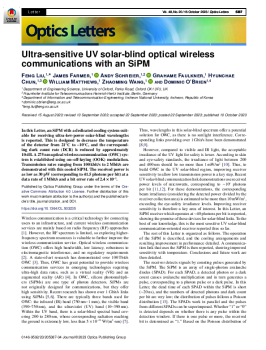Ultra-sensitive UV solar-blind optical wireless communications with an SiPM
Paper
My Twelth Paper
This work introduces a highly sensitive SiPM-based OWC system operating in the UV solar-blind spectrum, achieving significantly reduced power requirements and enhanced data transmission rates.
Abstract
In this Letter, an SiPM with a dedicated cooling system suitable for receiving ultra-low-power solar-blind wavelengths is reported. This is designed to decrease the temperature of the detector from 21°C to –10°C, and the corresponding dark count rate (DCR) is reduced by approximately 10 dB. A 275 nm optical wireless communication (OWC) system is established using on–off-keying (OOK) modulation. Transmission rates ranging from 100 kbit/s to 2 Mbit/s are demonstrated with this cooled SiPM. The received power is as low as 30 pW (corresponding to 41.5 photons per bit) at a data rate of 1 Mbit/s and a bit error rate of 2.4 × 10–3.
Key Findings
A Silicon Photomultiplier equipped with a specialized cooling system was developed, targeting ultra-low-power solar-blind wavelengths. This novel approach led to a substantial reduction in the dark count rate (DCR) of the SiPM when cooled from 21°C to -10°C, with a decrease of about 10 dB. An OWC system operating at a 275 nm wavelength using on-off-keying (OOK) modulation was established, demonstrating the capability to transmit data at rates ranging from 100 kbit/s to 2 Mbit/s. Impressively, this system was shown to function effectively with a received power as low as 30 pW (41.5 photons per bit) at a 1 Mbit/s data rate, while maintaining a low bit error rate of 2.4 × 10^-3.
The potential and challenges of using the ultraviolet (UV) solar-blind spectral band (200 to 280 nm) for OWC were highlighted due to its minimal interference from sunlight and adherence to safety standards for UV light irradiance. An enhanced sensitivity was observed in the newly developed SiPM receiver, which was reported to operate at around 40 photons per bit, a significant improvement over previous demonstrations that required approximately 10^4 photons per bit. This advancement marked an increase in sensitivity by roughly 240 times. The study concluded with suggestions for future work, focusing on the need to increase data rates and incorporate equalization techniques to address inter-symbol interference, thus contributing to the ongoing development in the field of UV solar-blind OWC.
